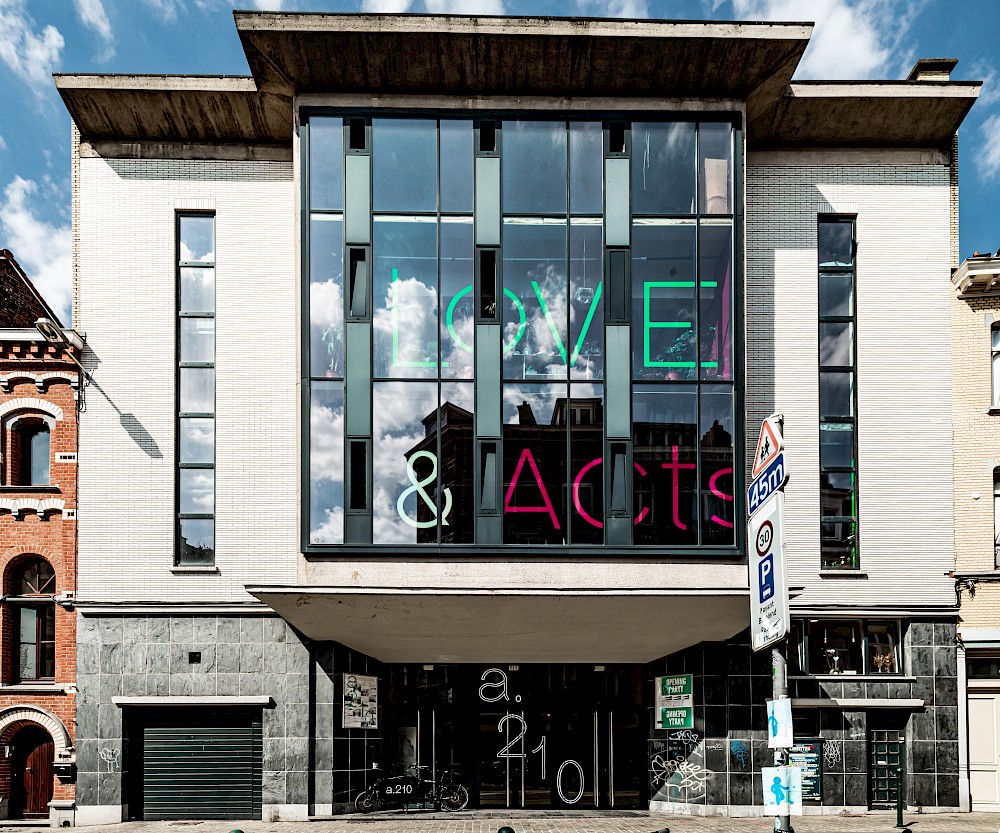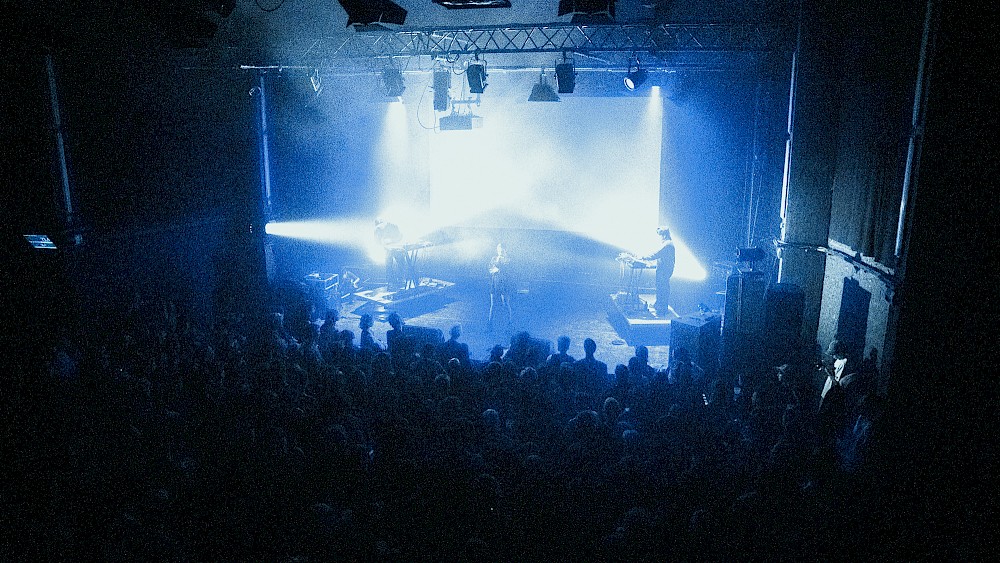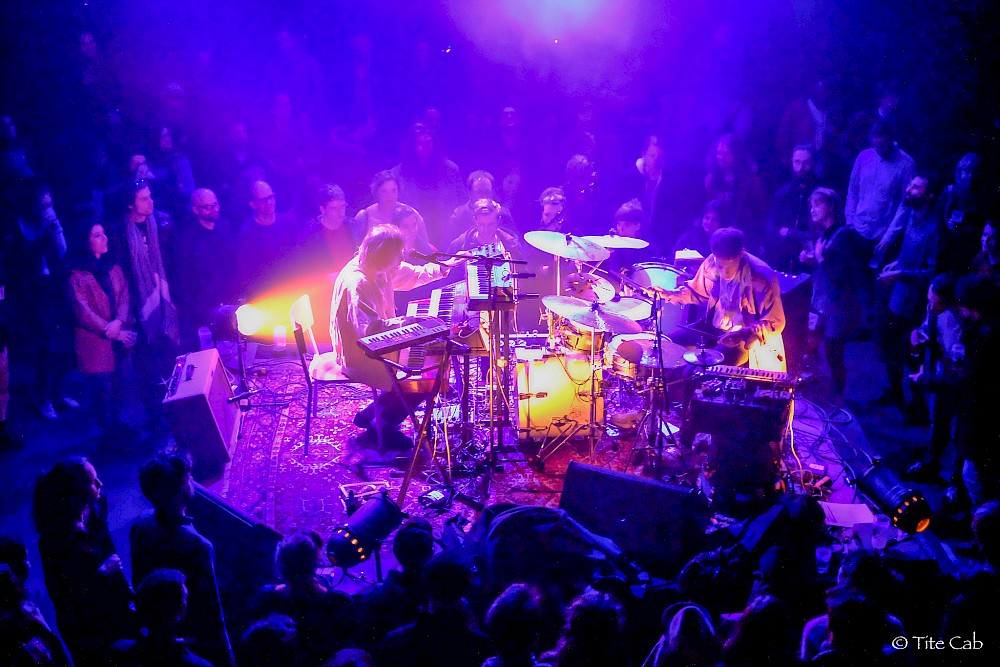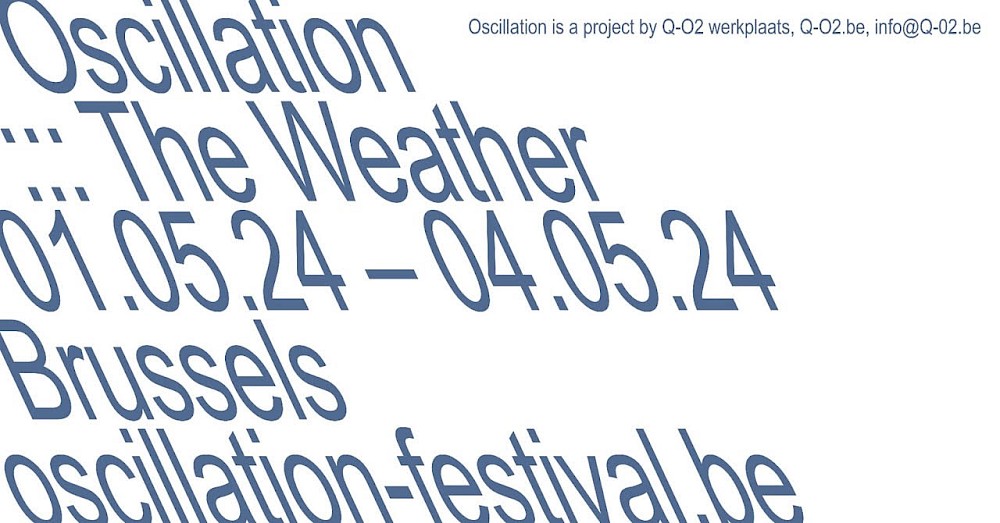- Concert
- Performance
- DJ
03.05.2025
Festival Oscillation
» ticketsHoraires
doors 18:00
tickets: 22€ standard price / reduced 19€: -26 + 65 years, jobseekers / (Festival Pass: 50eur/65eur : 4 days-festival)
· ouverture des portes 1h avant le début des concerts · doors open 1 hour before concert start time
Line Up
18:30 - 19:30: Conversation: Weather Patterns w/ d'incise, Pat Thomas, Ute Wassermann. Moderated by Stoffel Debuysere
***
20h Yara Mekawei
21h Sacred Realism : Cat Lamb, Bryan Eubanks, Rebecca Lane
22h break
22h30 Marja Ahti
23h15 Soumaya Phéline
0h-2h DJ set : Non Local Research
FESTIVAL OSCILLATION
FR - Festival Oscillation 2025
The Weather départ des pratiques autour du field recording – l’écoute de son environnement par le biais de microphones, de la mémoire ou du langage. Le festival associera le field recording à la météo en tant que phénomène, métaphore et concept, capable de produire des effets poétiques et magnifiques, mais aussi de manifester des événements radicalement destructeurs.
L'après-midi, à partir de 15 heures, Gabi Schaffner et Markus Stein diffuseront une radio en direct, Justin Bennett présentera une installation et Rory Salter réalisera une performance dans le jardin Jean-Félix Hap, situé à proximité.
El-Qibla est un voyage sonore qui résonne avec les dimensions spirituelles et sensorielles du son. Enracinée dans les enregistrements de terrain de Yara Mekawei lors de célébrations soufies dans les régions musulmanes d'Afrique, la performance transforme ces moments capturés en compositions complexes et immersives. Grâce à l'interaction entre les instruments africains traditionnels et les riches textures de ces enregistrements, Mekawei crée un paysage sonore dynamique qui oriente l'auditeur, tout comme la Qibla oriente la concentration spirituelle. Chaque couche sonore pulse avec une vitalité rythmique, guidant le public vers une connexion profonde avec les fréquences et les vibrations du moment. Cette performance incarne l'idée d'alignement, à la fois sonore et métaphysique. La Qibla, en tant que concept central, symbolise l'orientation et la convergence, ce qui se reflète dans la manière dont les compositions mettent en harmonie des sons disparates. En s'inspirant de rituels sacrés et de la vie quotidienne, l'œuvre jette un pont entre les pratiques anciennes et les interprétations sonores modernes, créant ainsi un espace de contemplation et de résonance.
Prisma Interius IV de Catherine Lamb a été développé à la fois auditivement et en collaboration avec Rebecca Lane et Bryan Eubanks pour une instrumentation ouverte d'instruments à hauteur non fixe. Cette pièce nécessite une transmission auditive dans le Secondary Rainbow Synthesizer (un synthétiseur numérique simple utilisant le filtrage en direct des champs sonores passants à l'extérieur de l'espace). Le matériel harmonique est filtré à partir de sons naturels et insufflé dans le timbre et les harmoniques des instruments et des voix. Prisma Interius est une grande série de 9 œuvres pour solo jusqu’orchestre de chambre, toutes basées sur les interactions en direct du Secondary Rainbow Synthesizer avec des champs sonores et des instruments.
To Admit is not to Enter, the Door is not an Ikon de Marja Ahti est une performance qui juxtapose des enregistrements de terrain, live electronics et des objets acoustiques et amplifiés, tout en construisant des ponts poétiques entre des environnements enregistrés, une instrumentation simple et des sons générés par des matériaux de tous les jours. La performance est ancrée dans une fascination pour la simple étrangeté des expériences humaines envers le son, et la perception plus largement - l'idée que dans les bonnes conditions les vibrations perçues par les tympans peuvent être ressenties comme quelque chose de profondément affectant, voire profond - quand nos réactions humaines ataviques interagissent avec l'expérience immédiate du son tel qu'il apparaît dans l'instant.
Soumaya Phéline explore le CDJism/turntablism en mettant l'accent sur l'aspect performatif du DJing, redéfinissant les CDJ, les platines et les tables de mixage comme des instruments créatifs. Son approche cinématographique transforme les morceaux en outils narratifs, créant ainsi une narration sonore immersive. Le jamming joue un rôle central, générant un riche réservoir de matériel audio et visuel pour l'échantillonnage et le raffinement des mouvements chorégraphiques. Repoussant les limites musicales et corporelles, elle équilibre précision et improvisation, embrassant l'esprit de réinvention inhérent au turntablism.
Depuis 2016, nous dirigeons la maison d’édition umland, qui produit des publications sur les cultures sonores, la création artistique et la réflexion critique.
EN - The 2025 festival Oscillation ::: The Weather departs from practices around field recording – listening to one’s environment through microphones, memory, or language. The festival will link field recording to the weather as phenomenon, as metaphor, and as concept, able to cause poetic and beautiful effects but also to manifest radically destructive events.
In the afternoon, from 15:00 there will be live radio by Gabi Schaffner & Markus Stein, an installation by Justin Bennett and a performance by Rory Salter in the nearby Jean-Felix Hap Park.
El-Qibla is a sonic journey that resonates with the spiritual and sensory dimensions of sound. Rooted in Yara Mekawei’s field recordings from Sufi celebrations across Muslim African regions, the performance transforms these captured moments into intricate and immersive compositions. Through the interplay of traditional African instruments and the rich textures of these recordings, Mekawei creates a dynamic soundscape that orients the listener, much like the Qibla directs spiritual focus. Each sonic layer pulses with rhythmic vitality, guiding the audience toward a deep connection with the frequencies and vibrations of the moment. This performance embodies the idea of alignment—both sonic and metaphysical. The Qibla, as a central concept, symbolizes orientation and convergence, reflected in the way the compositions bring disparate sounds into harmony. By drawing from sacred rituals and everyday life, the work bridges ancient practices with modern sonic interpretations, creating a space for contemplation and resonance.
Prisma Interius IV by Catherine Lamb has been developed both aurally and collaboratively with Rebecca Lane and Bryan Eubanks, eventually for open instrumentation of non-fixed pitched, sustaining instruments. This piece requires an aural transmission into the Secondary Rainbow Synthesizer (a simple digital synthesizer using bandwidth filtering of live sound fields outside the space). Harmonic material is filtered from natural sounds and breaths into the timbre and harmonics of the instruments and voices. Prisma Interius is a large series of 9 works for solo performer to chamber orchestra, all based around the interactions of the Secondary Rainbow Synthesizer with live sound fields and instruments.
To Admit is not to Enter, the Door is not an Ikon by Marja Ahti is a performance that juxtaposes field recordings, live electronics, acoustic and amplified objects, building poetic bridges between recorded environments, simple instrumentation, and sounds generated from everyday materials. The work is rooted in a lasting fascination with the simple strangeness of human experiences with sound, and perception more broadly — the idea that vibrations sensed by the eardrums can be experienced as something deeply affecting, even profound, under the right conditions – as our atavistic human reactions interplay with the immediate experience of sound as it appears in the moment.
Soumaya Phéline explores CDJism/turntablism with a focus on DJing's performative aspect, redefining CDJs, turntables, and mixers as creative instruments. Her cinematic approach transforms tracks into narrative tools, crafting immersive sonic storytelling. Jamming plays a central role, generating a rich pool of audio and visual material for sampling and refining choreographic movements. Pushing musical and bodily boundaries, she balances precision and improvisation, embracing the spirit of reinvention inherent in turntablism.










